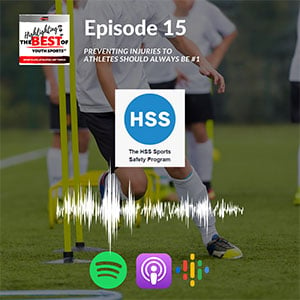Athlete Health Programs
Sports-related injuries continue to increase among both youth and adult athletes as participation in sports and recreational activities grows. The U.S. Centers for Disease Control and Prevention (CDC) reports that more than half of these injuries are preventable with proper resources and training. But programs that teach athletes how to reduce their risk of injury are often expensive or not widely available.
As the world leader in musculoskeletal medicine, HSS is dedicated to empowering athletes of all levels to participate in sports and recreational activities with minimal risk of injury. The exercise science, sports medicine and public health experts in the HSS Athlete Health program implement sport-specific research findings from the HSS Sports Medicine Institute into comprehensive athletic assessments and programming, with the overall goal of mitigating sport-related injuries. The mission of HSS Athlete Health is to enhance the sports experience with products and services that advance the health and wellness of athletes.
HSS Athlete Health, formerly known as HSS Sports Safety, was launched in 2016 to deliver evidence-based programming to reduce the risk of anterior cruciate ligament (ACL) injuries. Today, the team provides education and resources centered around neuromuscular control training to athletes of all ages and ability levels to mitigate the risk of all types of injury. Specifically, HSS Athlete Health delivers instructional content to clubs, schools, and leagues through the RIIP REPS app, designed and developed by Andrew Pearle, MD, Chief of Sports Medicine, and his colleagues at HSS. This is a free neuromuscular control training program for teams that helps participating athletes improve the control of their bodies during athletic movements like jumping, landing, and changing speed and direction while running.
Awards
- HSS Sports Safety wins Kevin G. Shea Award for Best Scientific Poster at the 2019 PRiSM Society Annual Meeting in Atlanta, GA
- ISAKOS Research Grant award winner for Cluster RCT of Implementation Strategies for ACL Injury Prevention
- HANYS' 2018 Community Health Improvement Award Nominee
Podcasts

Highlighting the BEST of Youth Sports Podcast - Preventing Injuries to Athletes Should ALWAYS Be Priority #1
Episode # 15 is an interview with Jimmy Russomano of the HSS Sports Safety Program. Listen on your platform of choice at:
In the News
- "Leaders Under 40" Class of 2023
- HSS to Offer Free Injury Prevention Program for 50 U.S. High Schools via New “Move Better Play Better” Initiative
- Age, Not Specialization, Predictive of Injury
- NYJTL Partners with Hospital for Special Surgery
- Development for Health & Physical Education Teachers
- NBA Players Will Host Virtual Training Sessions With Five-Star Basketball
- Talk About It Tuesdays Recap: Preparing for My Upcoming Season
- 'Return to Play' guide shows how children can play sports during coronavirus pandemic
- HSS Offers Free Daily Virtual Physical Education Classes for Students in Grades 3 through 12
- Focus on injury prevention, wellness earns top mark for Bound Brook High girls basketball
- How one high school wrestling team dramatically increased participation by putting kids first
- From Balance Beam To A Well-Balanced Diet, Wendy Hilliard Gymnastics More Than Sport
- HSS Leading Efforts on Sports Safety Across the Nation
- New ACL Injury Prevention Course Available on NFHS Learning Center
- HSS CEO: We Owe Parents Awareness on Sports Health Risks, Benefits
- Find the Best Sport for You: Aspen Institute Releases 1st Tool to Assess Health Benefits of High School Sports
- ACL Injuries In Youth Athletes Will Be Subject Of Free Hour-Long Program In White Plains
- Sideline Data - Pitch Counts
- Health experts offer tips on how to prevent youth ACL injuries
- Environmental & Health Education Comes To Harlem's Only Gymnastics Camp For NYC Youth
- Three Things Organizers and Coaches Can Do to Prevent Injuries in Youth Sports
- More Young Athletes Are Getting Injured — Why, and How, to Stop It (Hint: Cutting Playing Time Won't Do It)

events delivered

individuals reached

partner organizations
